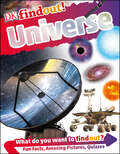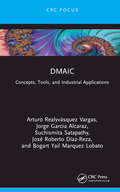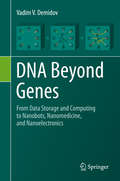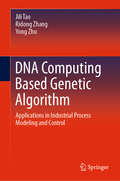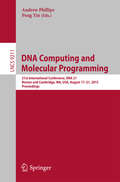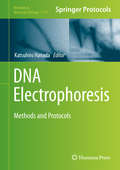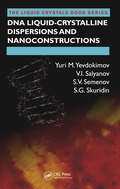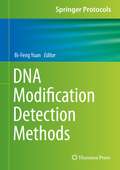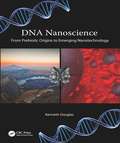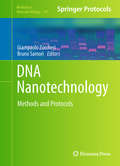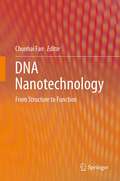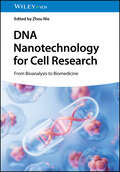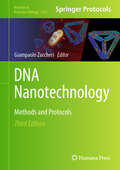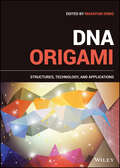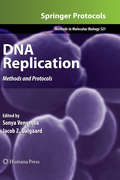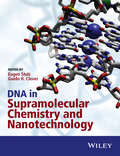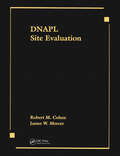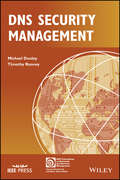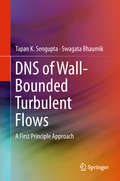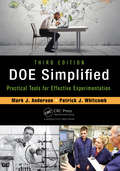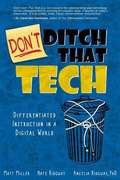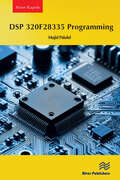- Table View
- List View
DKfindout! Universe (DK findout!)
by DKExplore stars, galaxies, and our incredible universe with this children&’s book full of photographs and illustrations, fascinating facts, and engaging challenges—from the creators of DKfindout.com, DK&’s free online resource for kids.Did you know that the sun takes 240 million years to make one orbit around the Milky Way? Or that astronauts learn what it feels like in space by training underwater? Find out why!Perfect for all young Earthlings who want a highly visual STEM book to increase their space know-how, DK findout! Universe is sure to inspire the next amazing science fair project or school report. Inside, author Giles Sparrow breaks down the universe and our place in it.With this DK findout! book, you will:- See meteors, comets, asteroids, and the eight planets of our solar system- Learn how astronomers measure cosmic distances using light-years- Read about amazing astronauts, such as Buzz Aldrin and Neil Armstrong- Discover how people have tried to contact aliens over the years using space probes, satellite dishes, and radio signals- Explore night-sky star constellations like Cassiopeia, Centaurus, and Ursa Major- Hear from real-life expert Suzanna Randall what it's like to be an astronomer today- and find out much, much more!The DK findout! series of kids books helps children become experts on their favorite nonfiction subjects, from dinosaurs and ancient civilizations to space, coding, and cutting-edge technology. Learn more about space—and everything else—at www.dkfindout.com, the award-winning free educational website.
DKfindout! World War I (DK findout!)
by Brian WilliamsThis photo-filled book for kids ages 6–9 is the ultimate guide to the key facts, figures, and players of World War I. Educating young readers through a combination of close-up images, trivia facts, quiz questions, and fascinating tidbits, it&’s the perfect book for any kid who wants to learn more about military history.How did World War I start? Which statue was damaged in the lead-up to the United States entering the war? Which countries had the biggest army and the best weapons? Find out the answers to these questions and more in DKfindout! World War I, which features photographs and illustrations of war machines, battlefields, and world leaders from throughout the span of this widespread conflict. Readers will learn about both sides of the war—the Central Powers and the Allied Powers—as well as each country&’s motivation for entering the conflict. Sections on military strategy and life during the war delve deeper into central subtopics, and detail how advancements in military technology like tanks and chemical weapons changed the course of battles all across the European continent.Vetted by educational consultants, the DKfindout! series drives kids ages 6–9 to become experts on more than 30 of their favorite STEM- and history-related subjects, whether Vikings, volcanoes, or robots. This series covers the subjects that kids really want to learn about—ones that have a direct impact on the world around them, like climate change, space exploration, and rapidly evolving technology—making learning fun through amazing images, stimulating quizzes, and cutting-edge information. The DKfindout! series is one that kids will want to turn to again and again.
DMAIC: Concepts, Tools, and Industrial Applications
by Arturo Realyvásquez Vargas Suchismita Satapathy José Roberto Díaz-Reza Jorge Garcia Alcaraz Bogart Yail LobatoThe industry is currently facing a multitude of challenges on production lines that must be systematically addressed in order to improve quality and productivity. One commonly utilized methodology by companies is DMAIC (Define, Measure, Analyze, Improve, and Control), which has been proven effective through various case studies and is now considered a standard problem-solving approach. However, existing books on DMAIC often focus solely on defining concepts and tools, as well as showcasing case studies separately. This book consolidates all of these aspects into a single, user-friendly resource.DMAIC: Concepts, Tools, and Industrial Applications offers both theoretical and practical insights into the DMAIC methodology. It sequentially presents all stages of DMAIC, outlining activities, data collection, and analysis processes. By integrating DMAIC concepts, tools, and case studies, this book provides industry professionals with a comprehensive resource. Real-world case studies from companies that have successfully implemented DMAIC to enhance production processes are showcased, offering valuable insights and practical examples.This book serves as a valuable resource for professionals, students, and individuals responsible for improving industrial production systems. By consolidating theory, tools, and case studies into a single book, readers can gain a comprehensive understanding of DMAIC and its application in industry.
DNA Beyond Genes: From Data Storage and Computing to Nanobots, Nanomedicine, and Nanoelectronics
by Vadim V. DemidovThis is the first book portraying to a wide readership many fields of DNA in the world of materials altogether in a single volume. The book provides underlying concepts and state-of-art developments in the emerging fields of DNA electronics, structural DNA nanotechnology, DNA computing and DNA data storage, DNA machines and nanorobots. Future possibilities of innovative DNA-based technologies, such as DNA cryptography, DNA identity tags, DNA nanostructures in biosensing and nanomedicine, as well as DNA-based nanoelectronics are all covered, too. This book is valuable for university students studying engineering and technology; biotech, nanotech, and medical device R&D managers, practitioners and investors; and IP analysts who would like to extend their background in advanced DNA technologies. It is nicely illustrated, which makes it very readable, and it conveys science and principles in a lively language to appeal to a broad audience, from professionals and academics to students and lay readers. Advance Praise for DNA Beyond Genes:“Most students of DNA, and lay readers as well, are interested in the absolutely essential role it plays in biology. However, the properties which make DNA the carrier of genetic information also make it an extraordinary material that can be used as the backbone for a wide variety of nanoengineering applications – these range from information storage and computation to molecular machines and devices to artfully designed logos and symbols. The perfect self-recognition of DNA sequences makes it an ideal building block to synthesize more and more elaborate constructions and imaginative scientists have probably only just scratched the surface of what can eventually be created. Here for the first time in this wonderful book Vadim Demidov explores the full range of the non-biological applications of DNA.”Charles R. CantorProfessor Emeritus of Biomedical Engineering, Boston University Member of the USA National Academy of Sciences
DNA Computing Based Genetic Algorithm: Applications in Industrial Process Modeling and Control
by Yong Zhu Ridong Zhang Jili TaoThis book focuses on the implementation, evaluation and application of DNA/RNA-based genetic algorithms in connection with neural network modeling, fuzzy control, the Q-learning algorithm and CNN deep learning classifier. It presents several DNA/RNA-based genetic algorithms and their modifications, which are tested using benchmarks, as well as detailed information on the implementation steps and program code. In addition to single-objective optimization, here genetic algorithms are also used to solve multi-objective optimization for neural network modeling, fuzzy control, model predictive control and PID control. In closing, new topics such as Q-learning and CNN are introduced. The book offers a valuable reference guide for researchers and designers in system modeling and control, and for senior undergraduate and graduate students at colleges and universities.
DNA Computing and Molecular Programming
by Andrew Phillips Peng YinThis book constitutes the refereed proceedings of the 21st International Conference on DNA Computing and Molecular Programming, DNA 21, held in Boston and Cambridge, MA, USA, in August 2015. The 13 full papers presented were carefully selected from 63 submissions. The papers address all current issues related to biomolecular computing, such as: algorithms and models for computation on biomolecular systems; computational processes in vitro and in vivo; molecular switches, gates, devices, and circuits; molecular folding and self-assembly of nanostructures; analysis and theoretical models of laboratory techniques; molecular motors and molecular robotics; studies of fault-tolerance and error correction; software tools for analysis, simulation, and design; synthetic biology and in vitro evolution; applications in engineering, physics, chemistry, biology, and medicine.
DNA Electrophoresis: Methods and Protocols (Methods in Molecular Biology #2119)
by Katsuhiro HanadaThis volume explores the latest techniques used by researchers to study DNA electrophoresis, with focus on various species including bacteria, yeasts, and mammalian cells. The chapters in this book cover topics such as two-dimensional gel electrophoresis; DNA replication; pulsed-field gel electrophoresis; ChIP; and post-labeling/PAGE method for detection of DNA adducts. Written in the highly successful Methods in Molecular Biology series format, chapters include introductions to their respective topics, lists of the necessary materials and reagents, step-by-step, readily reproducible laboratory protocols, and tips on troubleshooting and avoiding known pitfalls.Cutting-edge and authoritative, DNA Electrophoresis: Methods and Protocols is a valuable resource for any researchers looking to learn more about this developing field.
DNA Liquid-Crystalline Dispersions and Nanoconstructions (Liquid Crystals Book Series)
by Yuri M. Yevdokimov V.I. Salyanov S.V. Semenov S.G. SkuridinThe discovery of the spatial structure of the double-stranded DNA molecule is one of the greatest achievements of science. It would not be an exaggeration to say that the DNA double helix is a distinguished symbol of modern biology. Divided into three parts, DNA Liquid-Crystalline Dispersions and Nanoconstructions covers the information presently a
DNA Methods in Food Safety
by Omar A. Oyarzabal Sophia KathariouMolecular typing of foodborne pathogens has become an indispensable tool in epidemiological studies. Thanks to these techniques, we now have a better understanding of the distribution and appearance of bacterial foodborne diseases and have a deeper knowledge of the type of food products associated with the major foodborne pathogens. Within the molecular techniques, DNA-based techniques have prospered for more than 40 years and have been incorporated in the first surveillance systems to monitor bacterial foodborne pathogens in the United States and other countries. However, DNA techniques vary widely and many microbiology laboratory personnel working with food and/or water face the dilemma of which method to incorporate.DNA Methods in Food Safety: Molecular Typing of Foodborne and Waterborne Bacterial Pathogens succinctly reviews more than 25 years of data on a variety of DNA typing techniques, summarizing the different mathematical models for analysis and interpretation of results, and detailing their efficacy in typing different foodborne and waterborne bacterial pathogens, such as Campylobacter, Clostridium perfringens, Listeria, Salmonella, among others. Section I describes the different DNA techniques used in the typing of bacterial foodborne pathogens, whilst Section II deals with the application of these techniques to type the most important bacterial foodborne pathogens. In Section II the emphasis is placed on the pathogen, and each chapter describes some of the most appropriate techniques for typing each bacterial pathogen.The techniques presented in this book are the most significant in the study of the molecular epidemiology of bacterial foodborne pathogens to date. It therefore provides a unique reference for students and professionals in the field of microbiology, food and water safety and epidemiology and molecular epidemiology.
DNA Modification Detection Methods (Springer Protocols Handbooks)
by Bi-Feng YuanUnderstanding the functional roles of DNA modifications relies on the accurate detection, quantification, and mapping of DNA modifications. Methods for deciphering DNA modifications have substantially improved over the last several years, which greatly revolutionize the field of DNA modifications. In addition to DNA cytosine methylation (5-methylcytosine, 5mC), the best-characterized epigenetic modification, many new modifications have been discovered to present in DNA in recent years. This book provides a comprehensive overview of available techniques and methods together with detailed step-by-step protocols for experimental procedures required to successfully perform analysis on various types of DNA modifications, including 5mC, 5-hydroxymethylcytosine (5hmC), 5-formylcytosine (5fC), 5-carboxycytosine (5caC), 5-hydroxymethyluracil (5hmU), 5-formyluracil (5fU), N6-methyladenine (6mA), β-D-glucosyl-5-hydroxymethyluracil (base J) and 8-oxo-7,8-dihydroguanine (OG). This laboratory manual is a valuable source for biochemists and molecular biologists from different fields who wish to investigate DNA modifications.
DNA Nanoscience: From Prebiotic Origins to Emerging Nanotechnology
by Kenneth DouglasDNA Nanoscience: From Prebiotic Origins to Emerging Nanotechnology melds two tales of DNA. One is a look at the first 35 years of DNA nanotechnology to better appreciate what lies ahead in this emerging field. The other story looks back 4 billion years to the possible origins of DNA which are shrouded in mystery. The book is divided into three parts comprised of 15 chapters and two Brief Interludes. Part I includes subjects underpinning the book such as a primer on DNA, the broader discipline of nanoscience, and experimental tools used by the principals in the narrative. Part II examines the field of structural DNA nanotechnology, founded by biochemist/crystallographer Nadrian Seeman, that uses DNA as a construction material for nanoscale structures and devices, rather than as a genetic material. Part III looks at the work of physicists Noel Clark and Tommaso Bellini who found that short DNA (nanoDNA) forms liquid crystals that act as a structural gatekeeper, orchestrating a series of self-assembly processes using nanoDNA. This led to an explanation of the polymeric structure of DNA and of how life may have emerged from the prebiotic clutter.
DNA Nanotechnology
by Bruno Samorì Giampaolo ZuccheriCurrently, nanotechnology is exposing the properties of DNA in unprecedented detail leading to new insights on the biological behavior and function of DNA. With the structural perfection of a self-assembling DNA nano-object, such as a DNA origami, it is clear how complex DNA is as a molecule, leading researchers to wonder how many different constructs could be designed and realized. DNA Nanotechnology: Methods and Protocols shows the procedures to follow in order to repeat methods that lead to such constructs or to the mastering of the characterization techniques used to study them. The chapters of this book are roughly divided into two parts: some cover the methods for preparing the nanostructures, from the rationale of the operations to the techniques for their handling, while other chapters deal more directly with advanced instrumental techniques that can manipulate and characterize molecules and nanostructures. Written in the highly successful Methods in Molecular BiologyTM series format, chapters contain introductions to their respective topics, lists of the necessary materials and reagents, step-by-step, readily reproducible laboratory protocols, and notes on troubleshooting and avoiding known pitfalls. Authoritative and accessible, DNA Nanotechnology: Methods and Protocols serves as an ideal guide to scientists of all backgrounds and aims to ignite interest and spur activity in this young and rapidly growing research field. Includes cutting-edge methods and protocols Provides step-by-step detail essential for reproducible results Contains key notes and implementation advice from the experts
DNA Nanotechnology
by Chunhai FanDNA nanotechnology: From structure to function presents an overview of various facets of DNA nanotechnology, with a particular focus on their promising applications. This book is composed of three parts. Part I, Elements of DNA Nanotechnology, provides extensive basic information on DNA nanotechnology. Part II, Static and Dynamic DNA Nanotechnology, describes the design and fabrication of static and dynamic DNA nanostructures. Recent advances in DNA origami, DNA walkers and DNA nanodevices are all covered in this part. Part III, Applications of DNA Nanotechnology, introduces a variety of applications of DNA nanotechnology, including biosensing, computation, drug delivery, etc. Together these provide a comprehensive overview of this emerging area and its broad impact on biological and medical sciences. This book is intended for post-graduates, post-doctoral researchers and research scientists who are interested in expanding their knowledge of DNA nanotechnology. It provides readers an impression of the latest developments in this exciting filed.
DNA Nanotechnology for Cell Research: From Bioanalysis to Biomedicine
by Zhou NieDNA Nanotechnology for Cell Research Comprehensive coverage of DNA nanotechnology with a focus on its biomedical applications in disease diagnosis, gene therapy, and drug delivery Bringing together multidisciplinary aspects of chemical, material, and biological engineering, DNA Nanotechnology for Cell Research: From Bioanalysis to Biomedicine presents an overview of DNA nanotechnology with emphasis on a variety of different applications in cell research and engineering, covering a unique collection of DNA nanotechnology for fundamental research and engineering of living cells, mostly in cellulo and in vivo, for the first time. Broad coverage of this book ranges from pioneering concepts of DNA nanotechnology to cutting-edge reports regarding the use of DNA nanotechnology for fundamental cell science and related biomedical engineering applications in sensing, bioimaging, cell manipulation, gene therapy, and drug delivery. The text is divided into four parts. Part I surveys the progress of functional DNA nanotechnology tools for cellular recognition. Part II illustrates the use of DNA-based biochemical sensors to monitor and image intracellular molecules and processes. Part III examines the use of DNA to regulate biological functions of individual cells. Part IV elucidates the use of DNA nanotechnology for cell-targeted medical applications. Sample topics covered in DNA Nanotechnology for Cell Research include: Selections and applications of functional nucleic acid toolkits, including DNA/RNA aptamers, DNAzymes, and riboswitches, for cellular recognition, metabolite detection, and liquid biopsy. Developing intelligent DNA nanodevices implemented in living cells for amplified cell imaging, smart intracellular sensing, and in cellulo programmable biocomputing. Harnessing dynamic DNA nanotechnology for non-genetic cell membrane engineering, receptor signaling reprogramming, and cellular behavior regulation. Construction of biocompatible nucleic acid nanostructures as precisely controlled vehicles for drug delivery, immunotherapy, and tissue engineering. Providing an up-to-date tutorial style overview along with a highly valuable in-depth perspective, DNA Nanotechnology for Cell Research is an essential resource for the entire DNA-based nanotechnology community, including analytical chemists, biochemists, materials scientists, and bioengineers.
DNA Nanotechnology: Methods and Protocols (Methods in Molecular Biology #2901)
by Giampaolo ZuccheriThis fully updated volume explores methods to create and use nanostructures for characterizing, targeting, and controlling the behavior of cells. Experts from around the globe present their procedures for designing, preparing, characterizing, and using DNA nanostructures, especially towards biological or materials science applications. Additionally, the study of fundamental aspects of nucleic acids, such as their pairing and stacking energy measured with optical tweezers, as well as the targeted delivery of lipid-encapsulated nucleic acid drugs, is also provided to complete the landscape of nanoscale nucleic acids methods. Written for the highly successful Methods in Molecular Biology series, chapters include introductions to their respective topics, lists of the necessary materials and reagents, step-by-step and readily reproducible laboratory protocols, and tips on troubleshooting and avoiding known pitfalls. Authoritative and cutting-edge, DNA Nanotechnology: Methods and Protocols, Third Edition serves as an ideal resource for researchers working on applications of DNA nanostructures in biotechnology and nanomedicine.
DNA Origami: Structures, Technology, and Applications
by Masayuki EndoDNA ORIGAMI Discover the impact and multidisciplinary applications of this subfield of DNA nanotechnology DNA origami refers to the technique of assembling single-stranded DNA template molecules into target two- and three-dimensional shapes at the nanoscale. This is accomplished by annealing templates with hundreds of DNA strands and then binding them through the specific base-pairing of complementary bases. The inherent properties of these DNA molecules—molecular recognition, self-assembly, programmability, and structural predictability—has given rise to intriguing applications from drug delivery systems to uses in circuitry in plasmonic devices. The first book to examine this important subfield, DNA Origami brings together leading experts from all fields to explain the current state and future directions of this cutting-edge avenue of study. The book begins by providing a detailed examination of structural design and assembly systems and their applications. As DNA origami technology is growing in popularity in the disciplines of chemistry, materials science, physics, biophysics, biology, and medicine, interdisciplinary studies are classified and discussed in detail. In particular, the book focuses on DNA origami used for creating new functional materials (combining chemistry and materials science; DNA origami for single-molecule analysis and measurements (as applied in physics and biophysics); and DNA origami for biological detection, diagnosis and therapeutics (medical and biological applications). DNA Origami readers will also find: A complete guide for newcomers that brings together fundamental and developmental aspects of DNA origami technology Contributions by a leading team of experts that bring expert views from different angles of the structural developments and applications of DNA origami An emerging and impactful research topic that will be of interest in numerous multidisciplinary areas A helpful list of references provided at the end of each chapter to give avenues for further study Given the wide scope found in this groundbreaking work, DNA Origami is a perfect resource for nanotechnologists, biologists, biophysicists, chemists, materials scientists, medical scientists, and pharmaceutical researchers.
DNA Replication
by Jacob Z. Dalgaard Sonya VengrovaSince the discovery of DNA structure and throughout the ensuing "DNA era", the field of DNA replication has expanded to cover a vast number of experimental systems. In DNA Replication: Methods and Protocols, expert researchers present a collection of techniques and approaches used to investigate DNA replication with an emphasis on the most recent technological developments. Beginning with several informative introductory review chapters, this extensive volume is organized for clarity while fully encouraging innovation by the mixing of methods to create new techniques. Written in the highly successful Methods in Molecular BiologyTM series format, chapters contain brief introductions to the topics, lists of the necessary materials and reagents, step-by-step, readily reproducible laboratory protocols, and notes on troubleshooting and avoiding known pitfalls. Comprehensive and cutting-edge, DNA Replication: Methods and Protocols provides an excellent tool for both established laboratories and individuals new to this exciting field of research.
DNA in Supramolecular Chemistry and Nanotechnology
by Eugen Stulz Guido H. CleverThis book covers the emerging topic of DNA nanotechnology and DNA supramolecular chemistry in its broader sense. By taking DNA out of its biological role, this biomolecule has become a very versatile building block in materials chemistry, supramolecular chemistry and bio-nanotechnology. Many novel structures have been realized in the past decade, which are now being used to create molecular machines, drug delivery systems, diagnosis platforms or potential electronic devices. The book combines many aspects of DNA nanotechnology, including formation of functional structures based on covalent and non-covalent systems, DNA origami, DNA based switches, DNA machines, and alternative structures and templates. This broad coverage is very appealing since it combines both the synthesis of modified DNA as well as designer concepts to successfully plan and make DNA nanostructures. Contributing authors have provided first a general introduction for the non-specialist reader, followed by a more in-depth analysis and presentation of their topic. In this way the book is attractive and useful for both the non-specialist who would like to have an overview of the topic, as well as the specialist reader who requires more information and inspiration to foster their own research.
DNAPL Site Evaluation
by Robert M. Cohen James W. MercerDNAPL Site Evaluation covers long-term contamination of ground water by DNAPL (dense non-aqueous phase liquids) chemicals. The book develops a framework for planning and implementing DNAPL site characterization activities. It provides detailed methods to identify, characterize, and monitor sites and analyzes their utility, limitations, risks, availability, and cost. Methods to interpret contaminant fate and transport are identified, and new site characterization methods are assessed. DNAPL Site Evaluation will maximize the cost-effectiveness of site investigation/remediation by providing the best information available to describe and evaluate methods to be used for determining the presence, fate, and transport of subsurface DNAPL contamination. The book will be a useful reference for groundwater professionals and environmental regulatory personnel.
DNS Security Management
by Michael Dooley Timothy RooneyAn advanced Domain Name System (DNS) security resource that explores the operation of DNS, its vulnerabilities, basic security approaches, and mitigation strategies DNS Security Management offers an overall role-based security approach and discusses the various threats to the Domain Name Systems (DNS). This vital resource is filled with proven strategies for detecting and mitigating these all too frequent threats. The authors—noted experts on the topic—offer an introduction to the role of DNS and explore the operation of DNS. They cover a myriad of DNS vulnerabilities and include preventative strategies that can be implemented. Comprehensive in scope, the text shows how to secure DNS resolution with the Domain Name System Security Extensions (DNSSEC). In addition, the text includes discussions on security applications facility by DNS, such as anti-spam, SPF, DANE and related CERT/SSHFP records. This important resource: Presents security approaches for the various types of DNS deployments by role (e.g., recursive vs. authoritative) Discusses DNS resolvers including host access protections, DHCP configurations and DNS recursive server IPs Examines DNS data collection, data analytics, and detection strategies With cyber attacks ever on the rise worldwide, DNS Security Management offers network engineers a much-needed resource that provides a clear understanding of the threats to networks in order to mitigate the risks and assess the strategies to defend against threats.
DNS of Wall-Bounded Turbulent Flows: A First Principle Approach
by Tapan K. Sengupta Swagata BhaumikThis book highlights by careful documentation of developments what led to tracking the growth of deterministic disturbances inside the shear layer from receptivity to fully developed turbulent flow stages. Associated theoretical and numerical developments are addressed from basic level so that an uninitiated reader can also follow the materials which lead to the solution of a long-standing problem. Solving Navier-Stokes equation by direct numerical simulation (DNS) from the first principle has been considered as one of the most challenging problems of understanding what causes transition to turbulence. Therefore, this book is a very useful addition to advanced CFD and advanced fluid mechanics courses.
DOE Simplified: Practical Tools for Effective Experimentation, Third Edition
by Mark J. Anderson Patrick J. WhitcombOffering a planned approach for determining cause and effect, DOE Simplified: Practical Tools for Effective Experimentation, Third Edition integrates the authors decades of combined experience in providing training, consulting, and computational tools to industrial experimenters. Supplying readers with the statistical means to analyze how numerous variables interact, it is ideal for those seeking breakthroughs in product quality and process efficiency via systematic experimentation.Following in the footsteps of its bestselling predecessors, this edition incorporates a lively approach to learning the fundamentals of the design of experiments (DOE). It lightens up the inherently dry complexities with interesting sidebars and amusing anecdotes.The book explains simple methods for collecting and displaying data and presents comparative experiments for testing hypotheses. Discussing how to block the sources of variation from your analysis, it looks at two-level factorial designs and covers analysis of variance. It also details a four-step planning process for designing and executing experiments that takes statistical power into consideration.This edition includes a major revision of the software that accompanies the book (via download) and sets the stage for introducing experiment designs where the randomization of one or more hard-to-change factors can be restricted. Along these lines, it includes a new chapter on split plots and adds coverage of a number of recent developments in the design and analysis of experiments.Readers have access to case studies, problems, practice experiments, a glossary of terms, and a glossary of statistical symbols, as well as a series of dynamic online lectures that cover the first several chapters of the book.
DON'T Ditch That Tech: Differentiated Instruction in a Digital World
by Matt Miller Angelia Ridgway Nate RidgwayDon't Ditch That Tech provides practical ideas to help you find the sweet spot where classroom devices meet students' needs. In this teacher-tailored guide, you'll find tips on how to handle cart/lab scenarios, develop attention-grabbing strategies, build metacognitive practices, and more--all with differentiation in mind. Whether you're a tech newbie or the school's device guru, you'll walk away with new understandings and strategies for transforming and diversifying your approach to teaching in a twenty-first-century world.
DSC/HISS Modeling Applications for Problems in Mechanics, Geomechanics, and Structural Mechanics
by Yang Xiao Musharraf Zaman Chandrakant S. Desai John Phillip CarterUnderstanding the mechanical behavior of solids and contacts (interfaces and joints) is vital for the analysis, design, and maintenance of engineering systems. Materials may simultaneously experience the effects of many factors such as elastic, plastic, and creep strains; different loading (stress) paths; volume change under shear stress; and microcracking leading to fracture and failure, strain softening, or degradation. Typically, the available models account for only one factor at a time; however, the disturbed state concept (DSC) with the hierarchical single-surface (HISS) plasticity is a unified modeling approach that can allow for numerous factors simultaneously, and in an integrated manner. DSC/HISS Modeling Applications for Problems in Mechanics, Geomechanics, and Structural Mechanics provides readers with comprehensive information including the basic concepts and applications for the DSC/HISS modeling regarding a wide range of engineering materials and contacts. Uniformity in format and content of each chapter will make it easier for the reader to appreciate the potential of using the DSC/HISS modeling across various applications. Features: • Presents a new and simplified way to learn characterizations and behaviors of materials and contacts under various conditions • Offers modeling applicable to several different materials including geologic (clays, sands, rocks), modified geologic materials (structured soils, overconsolidated soils, expansive soils, loess, frozen soils, chemically treated soils), hydrate-bearing sediments, and more.
DSP 320F28335 Programming
by Majid PakdelThis book provides a comprehensive, practical approach to understanding and implementing the programming concepts of the DSP 320F28335 microcontroller. It is an indispensable guide for both seasoned professionals and beginners interested in mastering the complexities of programmable digital signal processors (DSPs).Inside, you will embark on a journey through the world of DSPs, exploring various programming techniques and strategies tailored specifically for the 320F28335 microcontroller. From the fundamentals of DSP programming to advanced signal processing algorithms, this book covers it all. Each chapter is carefully crafted, offering clear explanations, step-by-step examples, and hands-on exercises to reinforce your learning. You will learn how to harness the power of the 320F28335 microcontroller to develop real-time applications.Whether you are a seasoned programmer looking to expand your knowledge or a beginner ready to dive into the world of DSPs, "DSP 320F28335 Programming"" will be your ultimate companion. With its comprehensive coverage, insightful explanations, and practical examples, this book is a must-have resource for anyone aiming to excel in the realm of digital signal processing programming.
